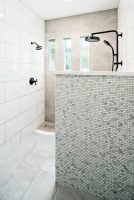Aging with Grace:
Preparing For Your Future Quality of Life
 The “forever home” phrase is one that brings about a vision of comfort, ease and enjoyment. A place to finally sit back and enjoy family, friends and the fruits of your labor. Between envisioning the celebrations and gatherings to come, we oftentimes overlook how our homes will serve our day-to-day life. As we age, our mobility and accessibility needs change. Is your home equipped with the conveniences to support your imagined quality of life for the next 20 years? If you’re considering a remodel, strategic planning and purposeful design selections can make future lifestyle adjustments easy as you age. Certified Aging in Place Specialists (CAPS) are interior designers who have completed additional educational courses focusing on design elements that allow you to continue living independently as you age.
The “forever home” phrase is one that brings about a vision of comfort, ease and enjoyment. A place to finally sit back and enjoy family, friends and the fruits of your labor. Between envisioning the celebrations and gatherings to come, we oftentimes overlook how our homes will serve our day-to-day life. As we age, our mobility and accessibility needs change. Is your home equipped with the conveniences to support your imagined quality of life for the next 20 years? If you’re considering a remodel, strategic planning and purposeful design selections can make future lifestyle adjustments easy as you age. Certified Aging in Place Specialists (CAPS) are interior designers who have completed additional educational courses focusing on design elements that allow you to continue living independently as you age.
Compiled by a few of our home remodeling experts, here are a few Aging in Place elements suggested for consideration by Sea Pointe Design & Remodel’s team of knowledgeable, Certified Aging in Place Specialists.
The Big Picture
Focusing first inside the home, start by having a CAPS professional assess your floor plan. Is your master bedroom and bathroom on the ground floor? Single story living eliminates the hassle of climbing stairs, ideal for those suffering from arthritic hip, knee or foot pain. Consider creating a space on the first story that can be used as a guest bedroom now, while providing an option to create a master bedroom and bathroom alternative for the future. A home designer can offer conversion options or help you determine the best approach to building additional square footage onto your home.
Included in her initial assessment of a home’s floor plan, CAPS Designer Lisa Greiner, values her Aging in Place education as framework for individualized design.
“The National Association of Home Builders (NAHB) identifies minimum width requirements for hallways, doorways and walkways intended for Aging in Place allowing for wheelchairs or other mobility options. Rather than simply satisfying these requirements, I take a client’s lifestyle into great consideration and use the NAHB specifications as a guideline. You should always design for the continued enjoyment of everyday living. Your home should be functional, assessable and most importantly comfortable!”
Shifting outside, Certified Aging in Place design is about minimizing maintenance while increasing ease of accessibility in your home. Oftentimes overlooked, the landscape and outdoor living areas that may surround your home are no exception. As supported by the National Association of Home Builders (NAHB), self-sustaining shrubbery and a low-maintenance vinyl or brick facade are beautiful, no-hassle options for maintaining curb appeal.
Aging in Place Bathrooms
Aging in Place has become synonymous with accessible bathrooms, and rightfully so! According to data collected by the Centers for Disease Control and Prevention, every year about 235,000 people over the age of 15 visit emergency rooms because of injuries suffered in the bathroom. Moreover, research shows that the number of injuries sustained between the ages of 65 and 75 more than doubles between the ages of 75 and 85. Ultimately peaking within the 85+ age group, bathroom injuries are easily reduced with thoughtful Aging in Place design.
What may seem like a non-issue now, the ease with which you step in and out of a shower area may change with age. When possible, a curbless shower can solve accessibility concerns without sacrificing style. For areas that call for balance support, especially in the shower and around a bathtub, grab bars offer secondary stabilization and are now offered in a variety of fashionable options. As you age, vision issues can impair one’s depth perception. Consider using different colored flooring materials where there is a step or change in floor level. In the shower, an adjustable or handheld showerhead offers comfort and safety allowing for one to be seated or standing.
While selecting your design materials, be mindful of textures. With an understanding of the differences in tile materials and fishiness, professional design guidance from a Certified Aging in Place Specialist is invaluable to making slip-resistant selections. Similarly, mindful decisions should be made when selecting plumbing and lighting fixtures. Various toilet heights are available as well as touch faucets making everyday use easy and stress-free. A proper lighting plan is also an important design element that should be considered, including general room lighting and task lighting.
Whether you’re planning for the next three years or fifteen years, designing with the future in mind deserves serious consideration. Kitchen and bath designers who have an Aging in Place education will expertly guide you through the remodeling process, adding style and safety to your “forever home” vision.